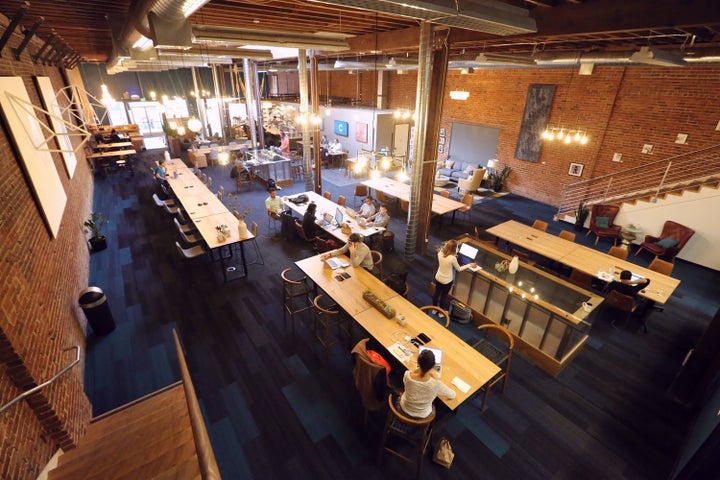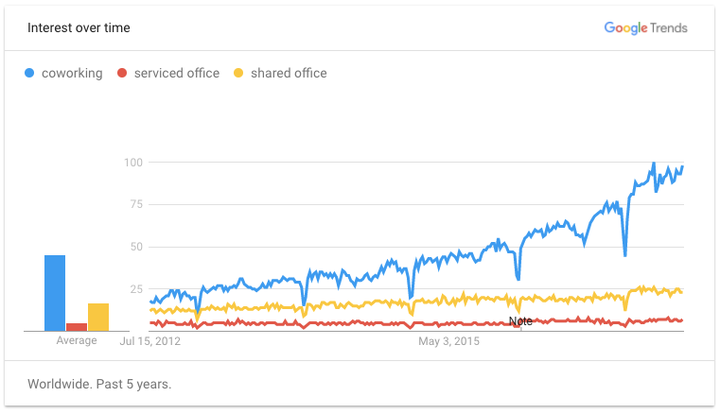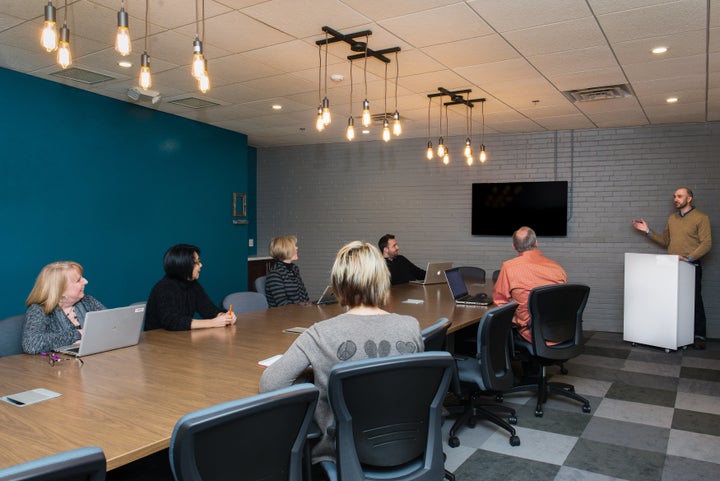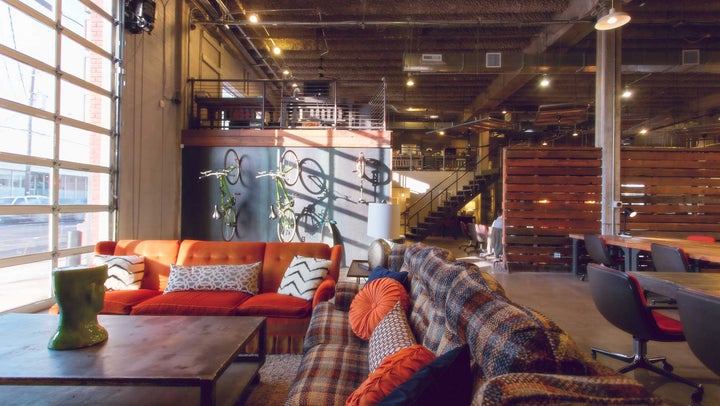
2017 saw continued growth of the flexible office industry and a broader range of offerings. While “Serviced Offices” have been around for decades (30+ years), the term “coworking” has been the media standard term for the last 10 years, and is likely here to stay according to the Global Workspace Association (GWA), a platform helping shared space operators, corporate real estate professionals, real estate investors, and service providers stay connected, current, and competitive.

The GWA is releasing results from their 2017 Industry Financial Survey, which is sent to hundreds of shared workspace operators, including association members and non-members. The survey gives us unique insight in that it covers specific P&L data from operators, with the goal to create industry benchmark data. But it goes beyond there. We can learn a lot about the future of workspace by studying spaces where people pay for workplace. Here are a few of the key takeaways:
1. Private Businesses and Landlords are getting into the flexible workspace game.
This year we’re seeing flexible options from landlords and private businesses grow faster than anyone expected. According to a recent Liquidspace report, 36% of the transactions on their platform are through private businesses or landlords offering extra space directly to consumers. Jamie Russo, Executive Director of the GWA, says, “The Commercial Real Estate industry may not have historically described itself as ‘nimble and innovative,’ but that may just be the behavior that we’re starting to see. This growth in transactions from landlords suggests demand for coworking, particularly from corporations, is growing. Landlords are increasingly seeking creative relationships with shared workspace operators in order to effectively activate their flexible offerings.”
The predominant approach is still the operator leasing the space, with 72% of respondents following that model. 19% of the respondents own their space, 3% reported a joint venture between the operator and the landlord, and 1% reported a management contract between the operator and the building owner. GWA research anticipates seeing less leasing and more operator/owner relationships in the next five years. As rent rates increase, the typical model is facing new challenges to remain profitable. Russo continues, “Growth of flexible office space offered by landlords will be an interesting evolution to watch over the next few years. I predict we will see an increased focus on the level of hospitality and community activation across flexible offerings, particularly in the context of a landlord offering a diverse portfolio of spaces. As corporations look to increase employee productivity with tools like flexibility, reduced commutes and compelling work environments, landlords will look to market their buildings by meeting that criteria and offering a variety of amenities, workspace configurations and managed communities to keep users engaged. Landlords may choose to partner with experienced coworking operators to deliver on hospitality and community activation.

2. There is an increasing focus on the user experience.
Two of the hottest buzzwords in the workspace industry right now are “consumerization” and “user-centered.” Everyone from landlords to corporate real estate departments to temperature control start-ups are focused on serving the “HDTV” consumer that expects a high level of design and hospitality at the corporate office, what we in the industry call their “third space.” Russo says, “What we are seeing is real estate evolving to be thought of not just as ‘buildings’ but as organic ecosystems that flex as their users’ needs change. As corporations start to look at off-campus options for employees, we see landlords pulling out all stops to attract users and taking really innovative approaches to amenities, workspace options and services.”
Highlights from the first half of 2017 that illustrate the user-focused industry trends:
· Convene raises $68M to fund expansion.
· Tishman and Speyer launches “Zo,” a high-amenity concept that aims to make its portfolio highly desirable and competitive.
· Banks—some of the most conservative, slow-moving, security-fearing companies—are using flexible office options as they grow teams in ancillary markets.
· Investments continue to flow into the coworking sector, indicating a bullish outlook for the continued growth of the consumerization of workspace: The Wing raises $8M, The Yard raises $15M in debt financing, WeWork added $300M to its balance sheet from Softbank, Industrious raised another $25M, and Asian companies added a long list of funded shared workspaces.
· Asset owners like Granite Properties and Stoneleigh Companies start installing coworking brands into their buildings (Common Desk and 25N Coworking respectively).

3. Open plan ≠ Coworking. Users are looking for productivity, not just a place to network.
Today 80% of coworking spaces offer private offices. While private spaces for individuals or teams make startup-costs higher for the operator, the demand seems to be growing for them.
Russo explains, “There is a big myth that coworking means open workspace. When the industry started to emerge in 2006, layouts were primarily open space and the hosts were focused around the simple idea of bringing people together to work. That approach worked for a period of time, but today the makeup of users and their space requirements is evolving.”
No longer are programmers and freelance designers the core membership. The GWA data shows that makeup of audiences today is 20% freelancers, 47% small business, and 12% mobile corporate users.

Steve King, partner at Emergent Research – a consulting firm focused on the small business sector of the US and global economy – shares some additional insight in the coworking audience evolution, “When coworking started, it was a movement predominantly around freelancers. Then around 2009 startups found coworking because they realized that signing a long-term lease didn’t make sense, and coworking fit right in. (Particularly in tech towns such as San Francisco, Boston, New York, and Austin.) What the GWA survey is showing is how the definition of flexible workspace is evolving. Much of the recent growth has been in corporate mobile users, and five years from now, I’d be surprised if they didn’t make up 35% of the coworking population. Small businesses (non-tech) are starting to move that way, but at a much slower pace.”
Freelancers are the individuals that are mostly doing computer work, so when coworking started it was focused there and open plan made sense. However, the demand for flexible office space is increasing through the sharing economy and is creating a shift in demand as corporate and small businesses users are on the rise. As the makeup of users shifts, the needs for layout in coworking spaces shifts, too. GWA data shows us the importance of variety in spaces in order to create the environment that makes coworking communities thrive. In fact, today’s data tells us that conference rooms and private offices are the most frequently offered spaces across all flexible workplace types. The supply side is reacting to that demand and creating more private spaces.

In many markets, the demand is higher for offices and team spaces, making them easier to fill. While some coworking purists idealize the open-plan for its community-building simplicity, this often comes without practical consideration for the type of work that gets done in shared workspaces. Russo says, “We see people saying they want a professional experience and a variety of usable spaces. The data suggest the market is starting to supply that in increasingly creative ways. People are expecting well-designed spaces that are also professional, and they are willing to pay for an experience that they can’t get from a home office or even a corporate campus. This is the consumerization of the work place.”
Data from members of shared workspaces indicates that the number two reason that people use shared workspaces is productivity. Some may lump networking under the productivity umbrellas (i.e. productively chasing new business under one roof), but it more likely means getting work done. For many, getting focused work done is simply easier to do in an area with four walls where you can control the stimuli (chatter, people walking by, Skype calls, etc.) Still, productivity looks different for different audiences, and that is changing the face of these spaces.
Russo closes with this thought: “The future is about flexibility, and a lot of corporations are still trying to figure out what that looks like for them and how to logistically manage it. The trend is moving toward choice, but the biggest shifts will come from gathering data that helps us measure and improve future offerings. What we have discovered with coworking is that professionals need other brains. You simply can’t do great knowledge work alone.”
If you’d like more information on the 2017 Industry Financial Survey take a look at this link for the executive summary. If you are interested in even more information, feel free to join the GWA Annual Conference in South Beach in September.
This article originally published in the Business of Furniture, a division of Bellow.Press on July 18, 2017. It is republished here with permission.
About the author: Amanda Schneider, LEED AP is a researcher, writer, consultant, and the founder of Contract Consulting Group, a research-led strategy firm focused exclusively on the Contract Interiors market. Do you work in the industry? Are you interested in getting PAID for your opinions? Click here to Join In for PAID market research opportunities!